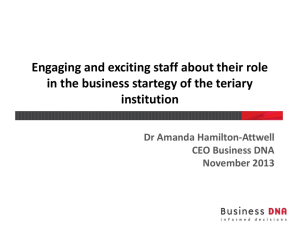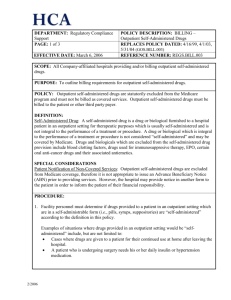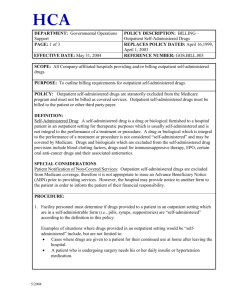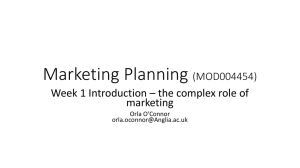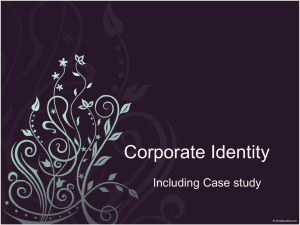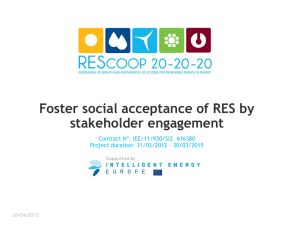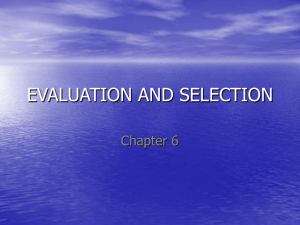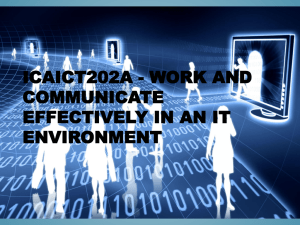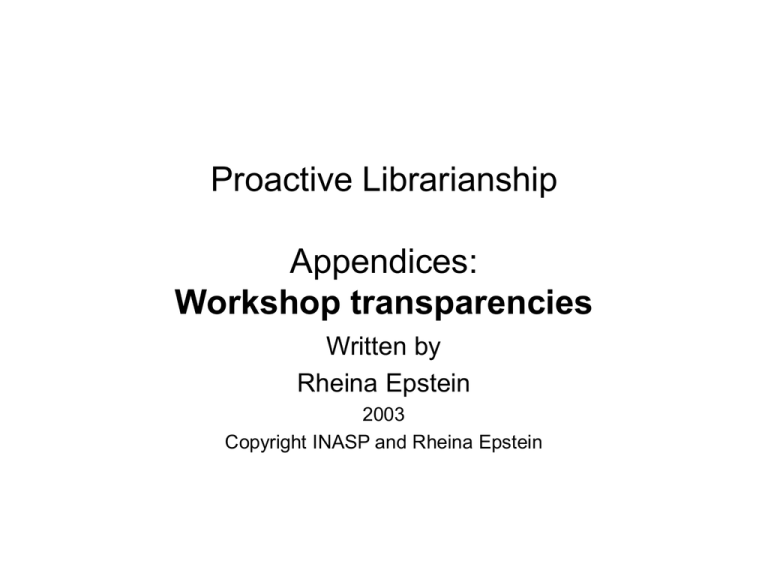
Proactive Librarianship
Appendices:
Workshop transparencies
Written by
Rheina Epstein
2003
Copyright INASP and Rheina Epstein
1. Meeting one another
• Your names and where you work
• Why you became a librarian
• What you hope to learn/achieve by your participation
here
2. Marketing: positive and negative
qualities of sales people
• Positive qualities
•
•
•
•
•
•
•
•
•
Communication skills
Articulate
Outgoing/extrovert (culture)
Assertiveness
Appropriate appearance and expression
Knowledge of product
Belief in product
Sensitivity to client-personality
Sensitivity to client’s needs/timing
Marketing: positive and negative
qualities of sales people
• Positive qualities
Honesty and credibility
Judgement in whom to approach
Energy
Willingness to go the extra mile
Strong self-esteem
Proactive
Understanding of business environment–what is possible/not
possible
Marketing: positive and negative
qualities of sales people
• Negative qualities
–
–
–
–
Pushy
Over-talkative
Avoidance of eye contact
Insincerity
3. Product analysis
• A checklist – but remember the often intangible
nature of what follows…
– For all libraries
• Information for different needs (who are the competitors
who also provide information?)
• Value-added service–selection, organisation, format,
accessibility
• Time and money saving
Product analysis
– For public libraries
• Educational, social and cultural development
• Support, reassurance
• Social contact
• Community venue/community advertising
• Contribution to Community Development–informed,
empowered and enabled community with social and
welfare and economic benefits
Product analysis
– For special and departmental libraries
• Not only information but knowledge and convenience
• Experience, competence, retrieval skills
• Competitive edge prestige & status
• Support for creative processes
• Improved performance at all levels
• Contributing to goals of organisation and realising its
values, namely innovative reputation, increased use of
products, profit margins
Product analysis
– For university libraries
• Learning materials for students
• Teaching and research materials for staff
• Inducement to attract donors, good staff, good students
Product analysis
– And finally, those who fund library services…
• What are they getting for their money and support?
4. What is marketing?
• Marketing is the entire activity of establishing our
markets or publics,
• determining their needs,
• investigating which products or service the various
publics believe will fulfil these needs,
• packaging our products or services,
• promoting them, and
• distributing them so that they are in the right place at
the right time (which should remind you of a basic
tenet of librarianship–getting the right book to the
right reader at the right time!)
What is marketing?
• Successful marketing is being able to persuade the
public that the product or service we offer will meet
their needs and very often the needs of which they
were unaware.
• It is important to conduct market research on user
needs–analyse your markets, their needs and
expectations. You can determine user needs through
surveys–questionnaires, interviews and focus groups.
• Knowledge of the organisation or the community is
vital.
• Never lose sight of the individual user.
5. The marketing mix
• The marketing mix is usually known as the 4 Ps, but
here we are adding three more*
•
•
•
•
•
•
•
Personality*
Product
Price
Place
Packaging*
Promotion
Passion*
The marketing mix
• Price
– According to Philip Kotler, the internationally-known authority
on the subject, marketing is not just about exchanging goods
for money. Not-for-profit organisations also market. What are
we offering to our users in exchange for what? Remember
that payment is not always in monetary terms
The marketing mix - price
• How do users of what is free at the point of access
actually “pay”?
– Through the time and energy they have to spend getting to it
– By adjusting to the hours of opening (not always convenient)
– Through the emotional energy required to deal with staff who
may not all be helpful, and with frustration in not finding what
they want
– Through overcoming bureaucracy to register
– Through overcoming bureaucracy to borrow
The marketing mix - price
• What about the competition?
– Other sources of information
– Other demands on the user’s time, and
– Particularly for the public library, other leisure and social
activities such as bookshops, videos, TV, and sport both
active and passive
The marketing mix
• Place
– Refers to the efficient distribution of our products:
– the location and number of our libraries
– the speed and efficiency with which the users receive what
they need (how locatable, identifiable, deliverable is the
information required in relationship to the acceptable time
and effort expended?)
The marketing mix
• Packaging
– This can be the appearance of the library and the
appearance and format of the information. The key here is
user friendliness.
•
Promotion
– Marketing is the entire activity of determining the user’s
information needs, establishing which product or services
the user believes will fulfil these needs, packaging and
distributing them for easy availability and finally promoting
them.
The marketing mix
How do you promote the product or service and
stimulate interest and support? Through: Public
Relations – below:
• Public Relations
– the climate in which any organisation operates and the
attitudes that people have towards it. Librarians need to
convey to users and potential users an image that not only
results in a positive attitude but also a positive action.
The marketing mix
• Branding–a brand is an image with added value. It
communicates personality. A brand is the name, sign,
symbol, design or combination of these that is used
to identify a good or service and distinguish it from its
competitors
• Advertising and publicity direct individual users to
the specific products that meet their needs.
• Publicity is to make something known through
different media or actions.
The marketing mix
• Advertising is a non-personal form of publicity or
communication through various media, the use of
which space or time has to be paid for by an
identified entity to create awareness of, interest in
and desire to possess or use the product or service.
The marketing mix
• Advocacy (or more familiarly lobbying) is a recent
form of promotion–pleading for a cause–advocating
for changes in policies and laws–more specifically
pleading for greater support to get more money.
• There is a need to co-ordinate all promotional
elements available to be effective because each of
these activities has a different focus.
• Librarians who know their product and who
communicate easily have in practically every human
contact an opportunity to promote not only the library
but also a specific resource.
6. Knowing your community:
a self-administered checklist
1. List the ways and techniques you can use to find out
about your community.
2. General characteristics–what are they?
Economic–wealthy, poor, sub-economic
Religion–denominations, other
Social–skilled, managers, labourers, gangs
Cultural
Political–parties, allegiances
3. Neighbourhoods with special characteristics–what
are they?
Knowing your community:
a self-administered checklist
4. What official offices are present and where?
5. What public utilities are available–water, electricity,
telephone?
6. What health care facilities are available–hospitals,
clinics, district nurses?
Knowing your community:
a self-administered checklist
7. What are the communication media? (You can
include town gossips if they play a major role!)
Printed–newspapers, notice boards, flyers, posters,
newsletters
Audio/visual–radio/TV
Internet cafes
People–social clubs, churches, clinics
(How do you personally keep informed of happenings and
events in your community?)
Knowing your community:
a self-administered checklist
8. Economic/commercial /industrial activities
What are dominant types of businesses and industries
(if any) in the area?
–
–
–
–
–
What are dominant types of businesses and industries (if
any) in the area?
What are the major means of livelihood?
Where do most people work i.e. do they have to go outside
the area/country?
What, roughly, are the proportions of
skilled/unskilled/clerical/managerial/professional groups?
Where do most people shop?
Knowing your community:
a self-administered checklist
9. Unemployment
–
–
–
–
What is the level of unemployment?
Who is unemployed?
What do the unemployed do?
Where do they spend their time?
10. What and where are the recreation and
entertainment facilities in the community?
Knowing your community:
a self-administered checklist
11. What groups and organisations are there in your
area?
12. Educational levels–what is the degree of literacy?
13. Educational facilities–do you have a list?
14. Who are the opinion leaders in your community?
15. Transport facilities–public/private
Have you any more questions to add?
7. Knowing your library users and nonusers
1. Library users
– Age, sex, language, groups?
– Where do they live?
– When do they use the library–and why?
–
2. Non library users–who does not use the library and
why?
Knowing your library users and nonusers
• 3. Library needs–perceived, actual, hypothetical
– How do you find out general information needs of the
community?
– How do you find out specific information needs?
– How do you find out what information needs are being met?
– How do you find out what information needs are being met
by other sources?
– What are the other needs being met by the library?
Knowing your library users and nonusers
4. With whom and what is your library competing?
5. How might you check on your answers?
6. What reference tools containing information about
your community do you have in your library?
8. Marketing library services to
management:
a self-administered questionnaire
• As practising librarians and information workers most
of you are already actively marketing your services to
management–although not necessarily in a
conscious manner. The following set of questions has
been designed to enable you to assess for
yourselves the extent to which what you are already
doing is actually marketing.
• There are no right or wrong answers–this exercise is
primarily for you own reflection and insight to make
you critically aware of what you are doing and to help
you develop an approach to and a perspective on
marketing.
Marketing library services to
management:
a self-administered questionnaire
1. What do you understand by marketing?
2. Why does your organisation or company exist?
–
–
–
–
–
Who are its competitors?
What is the structure of your organisation or company?
What are the different levels of management?
Where are you situated in the organisational structure?
What is your relationship to other departments/sections in
the organisation?
Marketing library services to
management:
a self-administered questionnaire
3. What services (products) are you actually offering to
your organisation?
– Does your organisation need your services?
– Does your organisation or company need its own information
services?
Marketing library services to
management:
a self-administered questionnaire
4. What does management expect of you? How do you
find out?
– What services do the various levels of management need?
Top management (those who make strategic decisions)?
Line management? Support services management?
– How do you identify and gather information on these needs?
– In terms of what is expected of you and what you can do,
what services could you be providing that you are not
providing currently?
– In the same way, what services are you providing that you
should not
Marketing library services to
management:
a self-administered questionnaire
5. Have you ever considered or measured the quality,
quantity and effectiveness of your services? How?
– Have you ever done a cost benefit analysis of your services?
How?
– With whom and with what are you competing for
management’s attention, time and money?
– How do you compare with other providers of the same or
similar service?
6. How available are your services to management?
Marketing library services to
management:
a self-administered questionnaire
7. How accessible are your services to management?
8. Who makes decisions regarding the library?
– To whom do you report?
– Who is/are the most powerful formal opinion leader(s)
affecting your library?
– Who is/are the most powerful informal opinion leader(s)
affecting your library?
Marketing library services to
management:
a self-administered questionnaire
9. What are the formal channels of communication?
–
–
–
–
–
What are the informal channels of communication?
What are the media of communication in your organisation?
How do you communicate with your immediate manager?
How do you communicate with top management?
How do you publicise to management at all levels what you
have done and what you can do?
– In what extramural activities of your organisation are you
involved?
Marketing library services to
management:
a self-administered questionnaire
10. How do you measure the success of your marketing
efforts?
11. What do you think are the ideal personal qualities
and characteristics required for the successful
marketing of your library services?
– To what extent do you personally measure to these ideals?
– Where do you fall short?
Marketing library services to
management:
a self-administered questionnaire
12. Do you see any merit in pursuing the line of
investigation embodied in this exercise?
– If not, why not?
– If yes, how would you continue?
Congratulations
You have just completed a basic exercise–examining
what you are currently doing! This is the first and
most crucial step in the marketing process.
9. The process of communication
• Five basic elements:
– The communicator who wishes to send the message.
– The message itself.
– The medium through which the message is physically
conveyed.
– The destination: the individual or group for whom the
message is intended.
– The feedback or reaction by which one knows whether the
message was successfully received and understood.
10. Media of communication
• Internal
– Personal contact: direct oral communication–feedback
potentially the greatest, especially when face-to-face.
– Personal contact: direct written communication–memos,
letters, notes, email.
– Meetings
– Notice board
– Newsletters/house magazines (These should be two way,
professional, regular, informative and entertaining).
– Group email/circulars
– Annual report
– Handouts/guides for new staff
Media of communication
• External
– Oral
• Person to person–either individual (but remember limited
time/availability) or group (remember concept of
“publics”).
• Visits/Tours–when requested or by invitation.
Media of communication
– Print media/DTP
• Publications such as:
• General guides/handouts on specific topics
• Booklists/bibliographies
• Newsletters
• Annual reports
• Remember the importance of distribution!
Media of communication
– Mass media
• Press releases, articles, interviews (not necessarily an
insider) for use in/on:
• Newspapers
• Journals/house magazines
• Radio & TV
• Film & video
• Internet-websites
Media of communication
– Special events/Public Relations techniques
• Official openings, exhibitions and displays (permanent
and mobile), events
• Outreach activities
• Friends of the library
• Give-aways–generate goodwill rather than attract new
users
– The performing and visual arts
• Provide creative artists with a forum to express
themselves, exhibit or perform. This creates another
medium of communication.
11. Non-verbal communication
• Staff:
– dress standards/badges/uniforms
– Body language:
• attitude/expression/posture/movements
• Library buildings:
–
–
–
–
–
Condition of building, tidiness, surroundings
Furniture
Equipment
Condition of stock/neatness/order
Notice boards/signs
• Vehicles
12. The benefits of reading for children
(the Product)
• Reading is a basic skill that impacts on a child’s
development.
• It increases technical ability (reading competency).
• It develops language skills–vocabulary heard in
conversation is reinforced when read in books.
• Rereading helps children internalise new vocabulary
and language structures.
• Reading improves comprehension and
communication skills.
• The print medium lets the reader to return to sections
not understood, thus allowing complex arguments to
be presented.
• Reading stimulates imagination and curiosity.
• It provides information, complementing what is learnt
at school. It is a resource for teachers.
• It provides for children’s emotional needs in terms of
an escape from reality. It provides resources to cope
with problems by providing solutions and the
opportunity to learn about similar experiences.
• It reinforces the child’s own language, culture and
environment.
• It broadens children’s horizons by exposing them to
other experiences, opinions, cultures, and peoples.
• It encourages the independent thinking required by
democratic societies.
13. Promoting library services to
children by reaching out to various
publics
•
•
•
•
•
•
•
•
The children themselves
Parents and close relatives
Teachers
Librarians
Suppliers such as writers, publishers and booksellers
Authorities (through lobbying)
NGOs
Donors and potential donors
14. Library services to young adults
–
–
–
–
–
–
–
Who are our users or potential users–our primary market?
What are their characteristics?
What are their needs, and how do we find them out?
What can the library provide?
What are we actually providing?
Who are the other stakeholders?
How do we market library services to them? (exchange
relationship)
– With whom can we establish partnerships?
– What do we actually promote? What methods do we use?
15. Library service to people with
physical disabilities
• What are the specific needs of people with
disabilities?
• Mobility–what does this mean?
• Accessibility–what does this mean?
• Culture of volunteerism
• Library material: content and format
• Other services provided–Adult Basic Education and
Training support
• Attitude of library staff
Library service to people with physical
disabilities
• What is currently available?
• Who are the stakeholders?
• Who needs to be directly involved?
– In exchange for what?
– In exchange for what? Joint initiatives/partnerships
16. Library services to Adult Basic
Education and Training
• What do you understand by illiteracy?
• How do you understand the relationship between
literacy and ABET?
• What needs in your community have you established
and how?
• What are you actually doing to advance literacy?
• How do you set about being more proactive
Library services to Adult Basic
Education and Training
• Identify the shareholders:
–
–
–
–
–
–
–
The National Library
Librarians
Library associations
Learners and their families
Teachers
Department of Education
Politicians and other policy
makers
– Employers–public service,
corporate or private
– Literacy and ABET
providers (NGOs)
– Publishers
– Writers
– Booksellers
– The media
– Social Welfare authorities
(all levels)
– Economic development
authorities (all levels)
Library services to Adult Basic
Education and Training
• Local community, for example optometrists
• Volunteers with ABET skills
• How do you market literacy and Adult Basic
Education and Training to them? (Exchange
relationship)
• Partnerships/sponsorships–Corporate Social
Responsibility (Remember the three levels–local
business, medium-sized business, and large
corporations, both national and international)
• Business plan/grant proposal
• How do you evaluate your results?
These transparencies are to accompany the booklet : Proactive
Librarianship: Marketing and Public Relations
A Manual for Workshop Presenters
By
Rheina Epstein
This training manual has been prepared following workshops held in Africa
on "Proactive Librarianship: Marketing and Public Relations" for librarians
and information workers, professional and paraprofessional, working in any
type of library. The manual has been created to provide a practical guide
for organisers and presenters of workshops in running successful training
events in their own region.
The text of the accompanying manual may be found on the INASP
website: http://www.inasp.info





